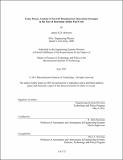| dc.contributor.advisor | R. John Hansman. | en_US |
| dc.contributor.author | Morrison, James K. D. (James Kelley Douglas) | en_US |
| dc.contributor.other | Massachusetts Institute of Technology. Technology and Policy Program. | en_US |
| dc.date.accessioned | 2011-08-30T15:43:29Z | |
| dc.date.available | 2011-08-30T15:43:29Z | |
| dc.date.copyright | 2011 | en_US |
| dc.date.issued | 2011 | en_US |
| dc.identifier.uri | http://hdl.handle.net/1721.1/65505 | |
| dc.description | Thesis (S.M. in Technology and Policy)--Massachusetts Institute of Technology, Engineering Systems Division, Technology and Policy Program, 2011. | en_US |
| dc.description | Cataloged from PDF version of thesis. | en_US |
| dc.description | Includes bibliographical references (p. 106-113). | en_US |
| dc.description.abstract | The air transportation system is a vital infrastructure that enables economic growth and provides significant social benefits. Future increases and volatility in crude oil prices, as well as environmental charges, are likely to increase the effective cost of fuel. I investigate the impacts of effective fuel cost increase on the US air transportation system historically and perform a game theory analysis of the impact of manufacturer competition on the introduction of new, more fuel efficient aircraft. The cost of jet fuel increased 244% between July 2004 and July 2008, providing a natural experiment to evaluate how fuel price increase affected continental US networks and fleets. It was found that non-hub airports serving small communities lost 12% of connections, compared to a system-wide average loss of 2.8%. Increased effective fuel costs will provide incentives for airlines to improve fleet fuel efficiency, reducing the environmental impacts of aviation, but may cause an uneven distribution of social and economic impacts if small communities suffer greater loss of mobility. Government action may be required to determine acceptable levels of access as the system transitions to higher fuel costs. Technology innovation may act as a long-term hedge against increasing effective fuel costs, enabling mobility to be maintained. The single aisle commercial aircraft market segment is the largest, but has the longest running product lines. I hypothesize that competition has important effects on manufacturers' decisions to innovate that must be considered when designing policies to reduce fleet emissions. An aircraft program valuation model is developed to estimate expected payoffs to manufacturers under competitive scenarios. A game theory analysis demonstrates how the incentives to innovate may be altered by subsidies, technology forcing regulations, increased effective fuel costs, the threat of new entrants, and long-term competitive strategies. Increased competition may result in incumbent manufacturers producing re-engined aircraft while increased effective fuel costs may result in new aircraft programs. Incumbents' optimal strategies may be to delay the entry of new single aisle aircraft until 2020-24, unless technology forcing regulations are implemented. | en_US |
| dc.description.statementofresponsibility | by James K. D. Morrison. | en_US |
| dc.format.extent | 113 p. | en_US |
| dc.language.iso | eng | en_US |
| dc.publisher | Massachusetts Institute of Technology | en_US |
| dc.rights | M.I.T. theses are protected by
copyright. They may be viewed from this source for any purpose, but
reproduction or distribution in any format is prohibited without written
permission. See provided URL for inquiries about permission. | en_US |
| dc.rights.uri | http://dspace.mit.edu/handle/1721.1/7582 | en_US |
| dc.subject | Engineering Systems Division. | en_US |
| dc.subject | Technology and Policy Program. | en_US |
| dc.title | Game theory analysis of aircraft manufacturer innovation strategies in the face of increasing airline fuel costs | en_US |
| dc.type | Thesis | en_US |
| dc.description.degree | S.M.in Technology and Policy | en_US |
| dc.contributor.department | Massachusetts Institute of Technology. Engineering Systems Division | |
| dc.identifier.oclc | 746763971 | en_US |
